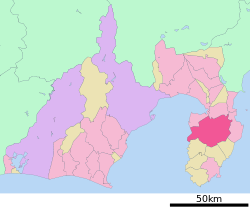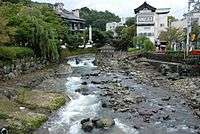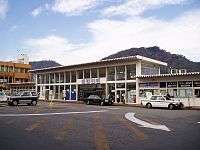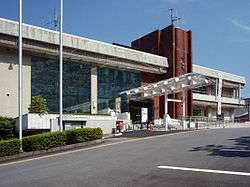Izu, Shizuoka
| Izu 伊豆市 | |||
|---|---|---|---|
| City | |||
|
Izu City Hall | |||
| |||
 Location of Izu in Shizuoka Prefecture | |||
 Izu
| |||
| Coordinates: 34°58′35.5″N 138°56′48.5″E / 34.976528°N 138.946806°ECoordinates: 34°58′35.5″N 138°56′48.5″E / 34.976528°N 138.946806°E | |||
| Country | Japan | ||
| Region | Chūbu (Tōkai) | ||
| Prefecture | Shizuoka Prefecture | ||
| Area | |||
| • Total | 363.97 km2 (140.53 sq mi) | ||
| Population (September 2015) | |||
| • Total | 31,265 | ||
| • Density | 85.9/km2 (222/sq mi) | ||
| Time zone | Japan Standard Time (UTC+9) | ||
| City symbols | |||
| • Tree | Quercus acutissima | ||
| • Flower | Wasabi | ||
| • Bird | Green pheasant | ||
| Phone number | 0558-72-1111 | ||
| Address | Kodachino 38-2, Izu-shi, Shizuoka-ken 410-2413 | ||
| Website | Official website | ||


Izu (伊豆市 Izu-shi) is a city located in central Izu Peninsula in Shizuoka Prefecture, Japan.
As of September 2015, the city had an estimated population of 31,265 and a population density of 85.9 persons per km2. The total was 363.97 square kilometres (140.53 sq mi).
Geography
Izu is located in the north-central portion of Izu Peninsula, and includes most of the Amagi Mountains. The region is hilly and some 80% of the city area is covered by forest. The Kano River runs through the city, which has a short coastline to the west on Suruga Bay of the Pacific Ocean. The area has numerous hot springs. Warmed by the warm Kuroshio Current, the area enjoys a warm maritime climate with hot, humid summers and mild, cool winters.
Surrounding municipalities
History
During the Edo period, most of Izu Province was tenryō territory under direct control of the Tokugawa shogunate, although portions near modern Shuzenji were under the control of the Okubo clan of Ogino-Yamanaka Domain. During the cadastral reform of the early Meiji period in 1889, the area was reorganized into several villages under Kimisawa District, Shizuoka Prefecture. Kimisawa District merged with Tagata District in 1896.
Shuzenji became a town in 1924, followed by Toi in 1938, Nakaizu in 1958, and Amagiyugashima in 1960.
The modern city of Izu was established on April 1, 2004 by the merger of the towns of Shuzenji, Toi, Nakaizu and Amagiyugashima (all from Tagata District).
Economy
The economy of the city of Izu is centered on tourism (primarily hot spring resorts), farming/forestry and commercial fishing. Izu is noted for its production of wasabi and shiitake. During the Edo period, the area was also known for its production of gold and other ores; however, the last commercial mining operations were closed in the 1960s.
Education
Izu has seven elementary schools, four middle schools and two high schools.
Transportation
Railway
Highway
Local attractions
Sister city relations
-
 - Nelson, British Columbia, Canada,[1] from August 18, 2005
- Nelson, British Columbia, Canada,[1] from August 18, 2005 -
 - Hope, British Columbia, Canada,[1] from August 18, 2005
- Hope, British Columbia, Canada,[1] from August 18, 2005 -
 - Minamiminowa, Nagano, Japan, from February 25, 1991
- Minamiminowa, Nagano, Japan, from February 25, 1991
Noted people from Izu
- Naoko Ken - singer, actress
- Yurika Ochiai - voice actress
- Sōsuke Kaise - manga artist
- Honinbo Shuwa - professional go player
External links
| Wikimedia Commons has media related to Izu, Shizuoka. |
- Official website (Japanese)
References
- 1 2 "International Exchange". List of Affiliation Partners within Prefectures. Council of Local Authorities for International Relations (CLAIR). Retrieved 21 November 2015.
